RogueRose
International Hazard
    
Posts: 1585
Registered: 16-6-2014
Member Is Offline
|
|
Reactions of Cu and 12.5% NaClO - CuO produced and some other strange side products
I needed some CuO and wanted to find a way to get it without decomposing something like CuSO4 or other copper salt or by repeatedly burning it and
somehow removing the oxide layer. So I tried using concentrated bleach and it seemed to have great results at first but towards the end of the
reaction, there seemed to be some side products being produced and some unexpected reactions.
The reaction of a 12.5% NaClO solution with copper wire has produced some varied and odd results which I am trying to determine. I started with a few
small samples of about 200g of Cu and 150ml of bleach solution. This started to produce an oxide layer after about 5 minutes and after about 15
minutes the wires were largely covered with black oxide - shaking would leave a cloudy solution of oxide particles. Bubbles are emitted from the
reaction which do not seem to have a noticeable smell. The reaction was done at room temperature and no tests were done at higher or lower temps. In
all reactions a large excess of Cu wire was added as the goal was to produce CuO as quickly as possible.
If the mixture is allowed to sit for 6+ hours, there often is a reaction which produces aqua green coating and powder on the wire in some spots. If
allowed to sit for some time, the greenish areas grow in size.
Another reaction has been the emergence of a brown precipitate after at least 18+ hours - with the mixture being shaken, stirred, mixed 4-6 times over
this period. The black oxide precipitate has seemed to turn brown at the bottom of the container while not on the wires themselves - that seems to
stay black.
I also tried adding some H2SO4 at about 30% concentration (battery acid) in a small amount of 1ml per 75ml of 12.5% NaClO (50ml per gallon). This
small addition made a substantial difference in the speed of evolution of bubbles and black oxide produced in the mixture. I would venture an increase
of 3-4 times faster than without the acid added. I don't know if the reaction slowed as the acid was "used up" or if it continued at the increased
rate until the NaClO was consumed.
It seemed that the reaction would be completed in 24 hours if the acided was added as there was no smell of bleach in the liquid after this point and
it didn't have any slimy feeling - it may have had fractions of a percentage as I didn't test at this point.
(ODD behaviour batch)
In one case, where the acid had been added, after 18 hours of mixing (every 2 hours) then allowed to rest for 12 hours, the clear liquid was decanted
(about 85% of the liquid - oxide layer on bottom remained) and the same liquid (decanted from a previous batch) was poured into the mixture. This
liquid had already run through the oxidation process and was largely water and I'm guessing NaCl. A strange reaction happened immediately where the
water turned a cloudy brown and was very opaque. I poured slowly and carefully as not to agitate the settled precipitate (though I'm sure some was
kicked up) so IDK how or why the solution turned brown and cloudy so quickly. This was allowed to sit/settle for 24 hours and it remained cloudy and
seemed to not settle at all. 48 hours after mixture it was remained largely the same so it was decanted and allowed to settle which it did somewhat
after 2-3 days with very fine precipitate which seemed to form clumps but would easily pass through 4 layers of coffee filter (the clumps broke up
with minimal agitation).
Stratified layers - Batch #2
When first adding the acid, I tried with a small batch after about 250ml of 12.5% bleach had oxidized to a black precipitate with some slight brown
spots appearing briefly at times. When adding small amounts of the acid (10-15ml of 30% H2SO4) the black precipitate slowly turned an aqua/green.
The bottom layer, about 3/4" of precipitate/oxide, turned this aqua color from the top down for about 1/2 the precipitate. After about 2 days it
stopped reacting with the bottom remaining black/brown. IDK if the acid had been "used up" or what. When it was thoroughly mixed, shaken, the
precipitate turned dark grey and started bubbling again very slowly. Addition of 15-20ml of the bleach solution initiated the bubbling again and the
solution seemed to stir/agitate itself to some degree and the milky grey solution seemed to form clumps of dark grey precipitate and settled. It
seemed that the addition of more bleach (50-60ml) would allow the entire solution to turn back to very dark grey to black.
This is what the progression looks like with Cu + 12.5% NaClO (250ml) + 5ml 30% H2SO4 - Pic-1 15 mins; pic-2 20 mins; pic-3 4 hours
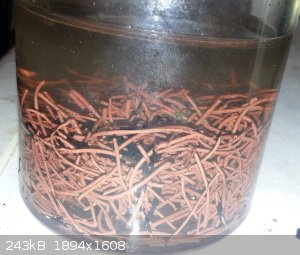 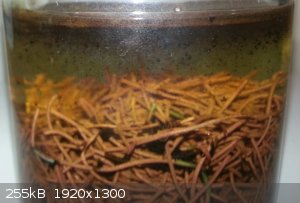 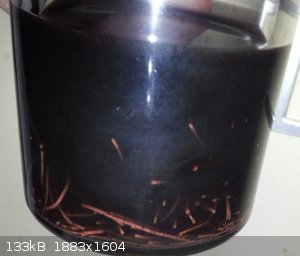
This is after about 30 hours with NaClO alone - with shaking every hour first 15 hours
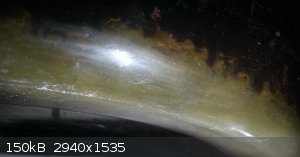 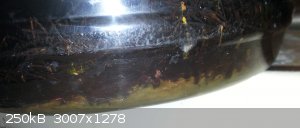
Result of allowing Cu & NaClo to sit undisturbed for 60+ hours
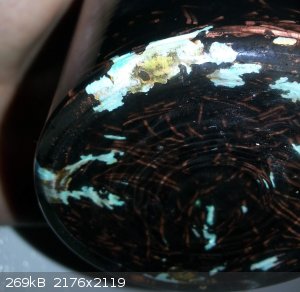 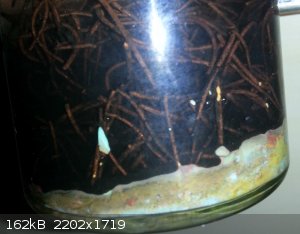 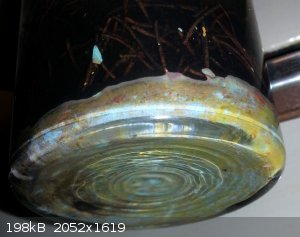
(ODD Batch reaction)
This is the result of the time I mixed the decanted solution. IDK how it turned muddy brown. No precipitate looked to be stirred up when poured in
& liquid turned muddy in 5-10 seconds. Could this be CuCl being formed?
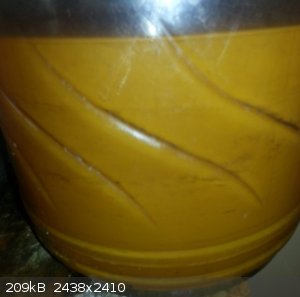
After solution had oxidized then added 8-10ml 30%H2SO4 and allowed to sit for 60 hours (Batch #2) -
more bleach was added to get it back to dark grey/blackish - 2 different bottles/mixes.
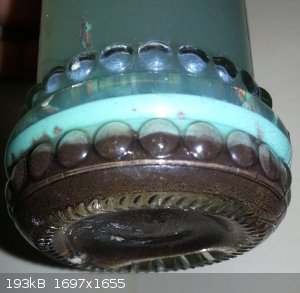 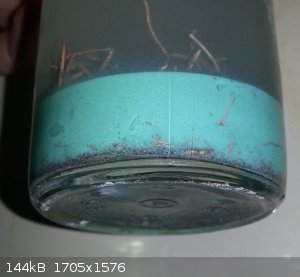
The following is from an oxidation batch where a 75:1 ratio of the 12.5%NaClO:30% H2SO4 was used - about 3-4 lbs of Cu wire is present. all pictures
are at the same time about 60 hours after first addition. Only stirring was used for agitation - final batch - #7
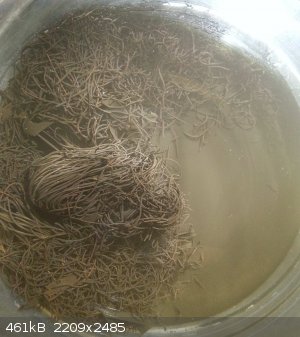 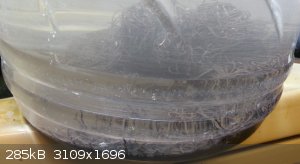  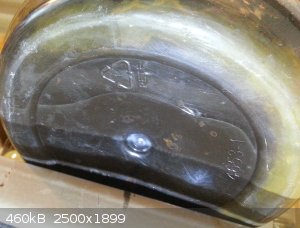 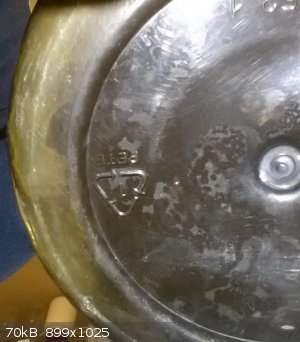
This is filtered and dried precipitate (batch 1-3) - some looked dark brown when wet
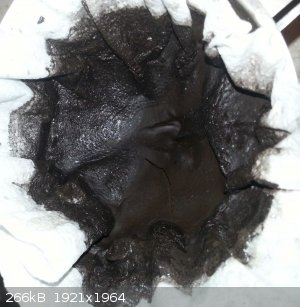
Same batch #4 - pic 1 is remainder (dried) in container after pouring into funnel
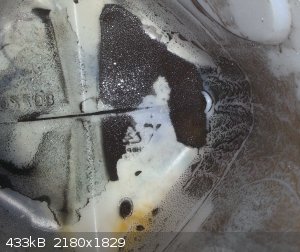 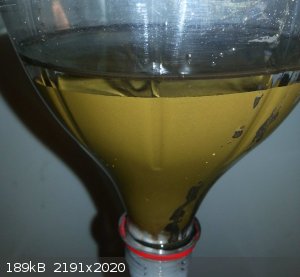
Both pics from batch #5 - some dried & rest still filtering
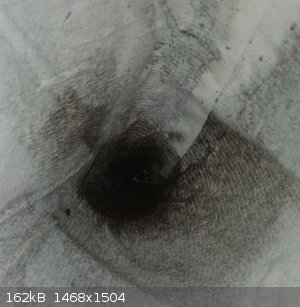 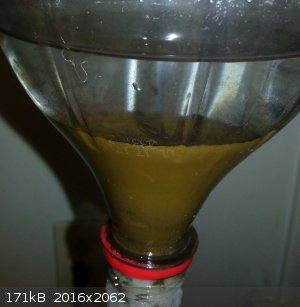
Final analysis of what is happening and what may have
happened
Cu + NaClO + H2O = CuO + NaCl + H2O - but what are the bubbles produced?
even when H2SO4 was added I have not noticed the smell of Cl2 at any point during this experiment. I would think that it most likely is O2 but I
think there might be a possibility of some H2 from some of the side reactions (if they are taking place)
So - I'm thinking there may be many side reactions going on here as it has been possible to get the aqua color as well as the brown color with only Cu
& hypochlorite and the gasses emitted. I'm guessing that these are the possible side reactions which may be possible in some aspects - IDK in
what degree/percentage.
CuO
Cu2O??
CuCl
CuCl2
Cu(OH)2
NaCl
NaOH
H2O
O2
H2
With the addition of H2SO4, IDK what is evolved from this but I do remember a feint smell of SO2 at the beginning stages after the addition of the
acid, so I don't think much sulfur stayed in this solution for very long. It may have made some CuSO4 and
CuSO4 + NaClO + H2O = CuO + SO2 + O2 + NaCl + H2O
The pictures towards the bottom with the settled brown precipitate as well as the final batch (#7) is what the end product moves towards when there is
an excess of NaClO added and allowed to sit for a few days. I have yet to dry it and see what it is exactly - whether it is CuO or CuCl. If it isn't
the oxide, then I'll have to look at the side reactions more closely as I know CuO is produced at first.
IDK if there is an easy way to produce CuO but this isn't difficult if the brown IS CuO. I've has some success with heating Cu in 30% (or stronger)
H2SO4 to boiling and it does produce a fair amount of fine CuO but also a lot of SO2 and it has to be baby-sat to a degree or at least checked on
regularly. Any suggestions on a good process would be appreciated.
Well, I'm sorry if this doesn't explain a lot, but it shows some interesting products that I definitely didn't expect and has been a good learning
experience for me.
|
|
|
clearly_not_atara
International Hazard
    
Posts: 2692
Registered: 3-11-2013
Member Is Offline
Mood: Big
|
|
IIRC sodium cuprate (III), NaCuO2, is an unstable dark-colored solid which gives dark solutions. It slowly decomposes to release oxygen, Na2O and CuO.
https://en.wikipedia.org/wiki/Cuprate#Oxides
http://www.sciencedirect.com/science/article/pii/00224596899...
I've wondered before if copper (iii) could oxidize guaiacols to benzodioxoles by cyclization of the chelate-complex
[Edited on 2-6-2017 by clearly_not_atara]
|
|
|
woelen
Super Administrator
        
Posts: 7976
Registered: 20-8-2005
Location: Netherlands
Member Is Offline
Mood: interested
|
|
You use excess copper in your experiments. In the presence of chloride ions, this leads to formation of very dark mixed oxidation state complexes,
which contain copper in oxidation states +1 and +2.
NaClO reacts with copper to form copper(II) oxide, which is black, basic copper(II) chloride (which is a mixed chloride/oxide), which is green, and
maybe you also get some hydroxide ions in the mix, also leading to a green color when combined with chloride.
If you add acid, then you get Cl2 from the bleach, which quickly reacts with the copper metal to CuCl2. If the liquid becomes less acidic, then again
you can get basic chlorides.
The most interesting thing is that if excess copper is used and all of your bleach is reduced to chloride, then very dark brown, nearly black complex
species are formed, like Cl-Cu-Cl-Cu-Cl, with the middle Cl-atom coordinated to both copper attoms. This type of complexes has a very dark color. At
very high dilution they are brown/green (like olives), but in somewhat higher concentrations they simply are black.
When such solutions are made alkaline, then you get a yellow/brown/mustard like precipitate, which is very impure Cu2O with Cl-atoms and copper(II)
ions mixed in as well. The purer the Cu2O the brighter the color (ranging from bright yellow/orange if no copper(II) is involved to muddy brown/green
when quite some copper(II) is present in the mix).
This page may be an interesting read for you:
http://woelen.homescience.net/science/chem/riddles/copperI+c...
It is not exactly under the same experimental conditions as in your case, but aspects of that chemistry certainly apply to your situation as well.
|
|
|
AJKOER
Radically Dubious
    
Posts: 3026
Registered: 7-5-2011
Member Is Offline
Mood: No Mood
|
|
Nice presentation Woelen!
---------------------------
If you seek CuO without heating try first preparing [Cu(NH3)4(H2O)2](OH)2 . I have prepared this by adding a very small solid piece of Copper metal to
an excess of dilute ammonia water + 3% H2O2 with a touch of sea salt. Optionally, one can jump start the reaction in a microwave for a few seconds.
Next create [Cu(NH3)4(H2O)2]CO3 by adding CO2, or just include the carbon dioxide in the first step or add a source of ammonium carbonate.
Then, warm the solution (after removing unreacted Cu metal), and pump air to evaporate the mix which will hopefully aid in converting Cu(l) to Cu(ll)
by the possible reactions:
2 NH4+ = 2 NH3 + 2 H+ (from an excess presence of ammonium carbonate)
1/2 O2 (g) + 2 H+ (aq) + 2 e- → H2O(l) (see Eq 6 at https://www.google.com/url?sa=t&source=web&rct=j&... which reviews NH3 leaching of copper minerals)
2 Cu(l) (aq) = 2 Cu(ll) (aq) + 2 e-
Net:
2 NH4+ (aq) + 1/O2 (g) + 2 Cu(l) (aq) → 2 NH3 (g) + 2 Cu(ll) (aq) + H2O (l)
In essence, we have produced a mix of cuprous and cupric oxides, but hopefully the small amount and low surface area of the solid Cu relative to
NH3/H2O2 may lower the cuprous creation per the equilibrium reaction:
Cu (s) + Cu(ll) (aq) = 2 Cu(l) (aq)
followed by the attempted action of oxygen, as noted above, to increase cupric content.
As partial support for my procedure, here is a quote from "Preparation of cuprous oxide", US Patent 2,474,533 (https://www.google.com/patents/US2474533):
"This solution, containing most of the copper in the cuprous state, on being distilled to recover the copper value as the oxides, and, barring any
oxidation in distilling, yields an oxide which is a mixture of cuprous and cupric oxides, the proportions of each being approximately the same as the
cuprous to cupric copper ratio in the solution before distilling."
One could also consider treating the dried powdered Cu2O/CuO mix briefly with cold chlorine bleach followed by washing. Assumed reaction:
NaOCl + Cu2O = 2 CuO + NaCl
Support: See http://www.chemicalforums.com/index.php?topic=10802.0
Here is a background reference on the reaction of NH3/Cu/H2O/O2, see https://www.academia.edu/292096/Kinetics_and_Mechanism_of_Co... which also cites a side reaction forming HNO2. The latter is unstable with
increasing concentration and lowering of the pH leading to massive nitrogen gas formation that may result in spillage and even rupture of closed
vessels.
[Edited on 2-6-2017 by AJKOER]
[Edited on 3-6-2017 by AJKOER]
|
|
|
|